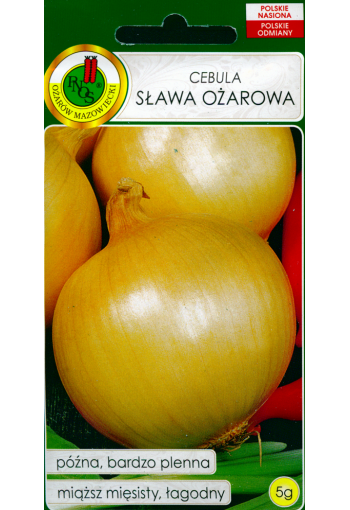Provides vitamins, suitable for salads, seasonings, first and second courses.
Late-ripening, high-yielding variety. One-, two-germ. The bulb is round, weighing 60-73 g. Dry scales are yellow, their number is 4. The neck is thick. The pulp is fleshy, the taste is semi-sharp.
Ripening before harvesting is 50-80%, after ripening 80-95%.
Recommended for growing in an annual crop from seeds. Commercial yield is 107-129 c/ha.
To obtain larger bulbs, seeds are sown for seedlings in March, and seedlings are planted in open ground in early May.
For a two-year crop, seeds are sown in open ground at the end of April - beginning of May, to a depth of 1.0-1.5 cm.
1.0 g = 250-350 seeds.
* It is necessary to grow onions during winter sowing and planting in areas not flooded by spring flood waters, with fertile, weed-free soils that have a soil solution reaction close to neutral (pH 6-7).
A prerequisite is constant illumination of the site during the day, it is impossible to allow the shading of plants, even by weeds. It is also necessary to provide for the possibility of watering.
In autumn, 5-6 kg of rotted manure or compost, 0.5-2 kg of lime materials or ash, as well as 50 g of nitrophoska are introduced under the digging (per 1 sq. M.).
Seeds are sown on ridges 1 m wide and 15-20 cm high according to multi-line patterns with a line spacing of 15-25 cm.
Sowing rate before winter - 1-1.5 g per 1 sq. m, planting depth - 1.5-2 cm. Before winter, only dry seeds are sown, calculating the sowing time so that they do not germinate before the onset of stable cold weather. It is advisable to mulch crops with peat or humus (1-2 cm layer), but not with sawdust.
After emergence, the seedlings are weeded, systematically (after 7-10 days) the aisles are loosened to a depth of 5-6 cm, preventing the soil from rolling against the plants, if necessary, they are watered. In the phase of one true leaf, onions are fed at the rate of 10 g per 1 sq. m of ammonium nitrate and potassium sulfate, and a month later - nitrophos (50 g per 1 sq. m). In the phase of 4-5 leaves, foliar feeding is given (0.5 g per 1 sq. M of the preparation, dissolved in 60 ml of water).
Onions are harvested during the mass lodging of leaves. When sowing under winter sowing, bulbs ripen 18-20 days earlier than during spring sowing, and the yield of turnip onions is 20-35% higher, while it is stored better.
When a small fraction of onion sets (less than 1 cm in diameter), is planted before winter, the plants grown from them do not shoot and give a high yield of large, well-ripened, lying bulbs. They ripen 15-30 days earlier than when planting onion sets in spring. Moreover, each plant grown from a small set, forms, regardless of the variety's nesting, as a rule, one bulb. Therefore, all varieties zoned for a given zone are suitable for subwinter cultivation.
Planting dates in Estonia are early October, so that before the onset of stable cold weather, the bulbs take root, but do not germinate.
From autumn, in advance, on a highly fertile (flood-free during a spring flood) site, ridges 1 m wide and 15-20 cm high are prepared.











